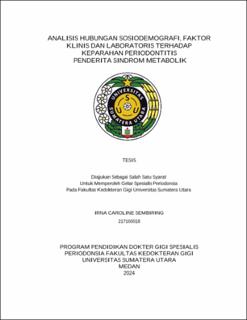| dc.description.abstract | Background: Periodontal disease is used to describe a group of diseases of condition that can cause inflammation and damage to the gingiva, periodontal ligament, cementum and alveolar bone. Periodontitis is inflammation of the periodontal tissue which has clinical features including pocket formation and alveolar bone resorption. Various factors can worsen periodontal disease, particulary periodontitis, one of which is systemic factors. Metabolic syndrome is one of the systemic factors that influence periodontitis. Metabolic syndrome is a group of symptoms consisting of increased waist circumference, increased blood triglyceride levels, decreased high density lipoprotein levels, high blood pressure, and glucose intolerance. Metabolic syndrome influences periodontitis through the general mechanism of oxidative stress. Metabolic syndrome and periodontitis increase oxidative stress thereby creating a pro-inflammatory state.
Objective: To analyze the relationship between sociodemographic, clinical and laboratory factors on the severity of periodontitis in patients with metabolic syndrome. Method: This research is an observational analytical study with a cross sectional approach. The number of samples in this study was 89 people who were selected according to the inclusion and exclusion criteria. Results: Sociodemographic factors, namely age, have a significant relationship with the severity of periodontitis in metabolic syndrome sufferers (p=0.001), There was no significant relationship between gender (p=0.133), education level (p=0.572) and the severity of periodontitis in metabolic syndrome sufferers. The clinical factors gingival index (p=0.125), papillary bleeding index (p=0.934) and oral hygiene index (p=0.474) were stated to have no significant relationship to the severity of periodontitis with a weak degree of relationship. Laboratory factors, namely interleukin-6 (IL-6), have a significant relationship with the severity of periodontitis with a moderate degree of relationship and a positive direction (p=0.001), gamma glutamyltransferase does not have a significant relationship (p=0.118).
Conclusion: Sociodemographic factors, namely age, and laboratory factors, namely IL-6, are associated with the severity of periodontitis in patients with metabolic syndrome. | en_US |


